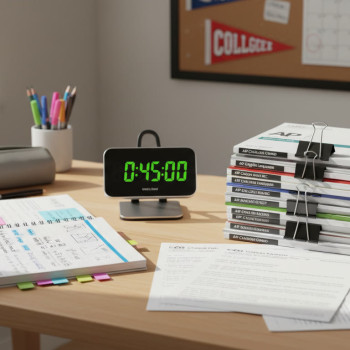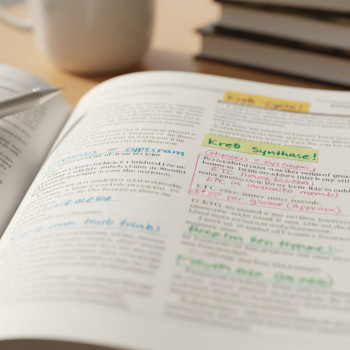Why Progress Checks Matter More Than You Think
It’s easy to treat progress checks like another checkbox: a short quiz your teacher assigns, you take it, and then—poof—it vanishes into the digital ether. But if you pause for a moment and look closer, progress checks are little goldmines of information. They are designed to do one thing well: reveal where your understanding is solid and where it’s fragile. When you learn to read them like a scientist reads data, the result is not just marginal improvement—it’s smarter studying, faster gains, and a calmer race toward exam day.

What progress checks are (and what they’re not)
Progress checks—especially those in AP Classroom—are unit-level formative assessments. They mix multiple-choice and free-response questions modeled on the AP exam so you can practice skills and content in context. But they aren’t meant to be the final judge of ability. They’re a diagnostic tool: they tell you where you should practice more, not whether you’re doomed or destined to ace the exam.
Three simple ways progress checks help you
- Targeted feedback: They pinpoint the specific topics and skills you need to work on.
- Habits over heroics: Regular low-stakes practice builds endurance and familiarity with question styles.
- Self-awareness: Over time, they reveal patterns in how you approach problems and time management.
Read the Report Like a Detective
When the results come in, don’t just glance at the percent correct and move on. A quick, ordered approach will make the data actionable:
1) Scan for big patterns first
Look at which topics or skills have the lowest scores across the progress check. If multiple questions on a single topic are missed, that’s a red flag for a foundational gap, not just a random slip-up. For example, if you miss several questions on hypothesis testing in AP Statistics, stop cramming tangential topics and plug that hole directly.
2) Study the rationales and scoring notes
Progress checks often include rationales for multiple-choice items and scoring guidelines for free responses. Read them. Don’t skim. Ask: Was your wrong answer a careless mistake, a misread, or a conceptual error? Each cause points to a different strategy.
3) Track recurring error types
Make a simple log: Careless, Misread, Conceptual, Process. After three progress checks, you’ll see which category shows up most. If “Careless” dominates, the fix is practice with conditions that simulate the exam (timers, quiet environment). If “Conceptual” shows up, you need concept-first study sessions—explanatory videos, teacher mini-lessons, or one-on-one tutoring focused on ideas rather than questions.
Turn Insight into an Action Plan
Information without action is busywork. Use the data to build a compact study plan that’s personalized, measurable, and time-boxed.
Step 1: Prioritize
Not all weak areas are equal. Sort topics by two criteria:
- Weight on the AP exam (how often it appears)
- Degree of weakness revealed by progress checks
High-weight + high-weakness = immediate priority. Low-weight + high-weakness might deserve less weekly time but still needs a plan.
Step 2: Build micro-goals
Micro-goals are 20–90 minute objectives that fit into your week. Examples:
- “Today: Rewatch AP Daily video on stoichiometry and complete three targeted practice questions.”
- “This week: Write and peer-review two short free-response responses to practice evidence use.”
Step 3: Use mixed practice
Don’t silo practice by topic for too long. The exam mixes topics. Alternate targeted practice (shoring up weak spots) with mixed sets that mimic the exam’s unpredictability.
Sample Two-Week Study Template (Built from Progress Check Data)
Below is a compact template you can copy and adapt. It assumes you’ve just finished a progress check and identified two priority topics and one recurring error type (for example, time management).
| Day | Focus | Activities (60–90 min) | Outcome Goal |
|---|---|---|---|
| Mon | Priority Topic A (Concept) | Targeted lesson + 5 practice problems + review rationales | Explain concept in own words; 80% on targeted questions |
| Tue | Mixed Practice | 20-minute timed mixed set (20 Qs) + quick error log | Improve time awareness; identify careless errors |
| Wed | Priority Topic B (Skill) | Guided problem solving + a free-response prompt + rubric practice | Gain stepwise solution strategy for common FRQ types |
| Thu | Peer Review / Tutoring | Discuss errors with a study partner or tutor; rework two problem types | Solidify understanding; receive feedback |
| Fri | Reflection + Light Review | Review week’s error log and re-attempt three missed questions | Decrease repeat errors; refine process |
| Sat | Practice Exam Block | 50–75 minute timed section; scoring and rubric calibration | Simulate exam conditions; practice pacing |
| Sun | Restorative Study | Light review (videos, flashcards), organize next week’s goals | Maintain momentum without burnout |
This two-week plan can repeat, shifting priorities as your progress checks change. The idea is to cycle, measure, and adapt.
Common Pitfalls and How to Avoid Them
Pitfall: Treating progress checks like straight-up practice tests
While they resemble AP-style questions, progress checks are formative. The goal should be learning from mistakes, not just counting scores. If you only chase the percent correct, you risk superficial gains. Instead, treat them as feedback loops: test, analyze, remediate, retest.
Pitfall: One-size-fits-all study plans
Your weakest topics aren’t necessarily the ones you should spend the most time on—context matters. For example, a topic that appears frequently on exams but is only slightly weak deserves strategic attention. Personalization matters; this is where targeted tutoring shines because a knowledgeable tutor can connect your errors to efficient fixes—whether that’s a different problem-solving method, mnemonic, or approach to free responses.
How to Use AP Classroom Reports Effectively
AP Classroom provides reports for both teachers and students. Here’s how to get the most from them:
- Use the topic breakdown to decide which question bank filters to apply during practice sessions.
- Look at question-level feedback to learn the common distractors—these reveal misconceptions.
- If your teacher allows, reattempt practice questions after targeted review to gauge improvement.
Example: Turning a weak progress-check section into strength
Imagine a progress check in AP Biology where you consistently miss enzyme kinetics questions. The report shows low scores on questions tied to Michaelis-Menten graphs and enzyme inhibition. A focused strategy would be:
- Relearn the graphical interpretation and slope relationships with short videos.
- Practice drawing and labeling curves by hand to build visual fluency.
- Do mixed problem sets that combine concepts (e.g., enzyme kinetics + regulation) so you can apply the idea in context.
- Write a short explanation in your own words for each type of inhibition—you remember what you put into words.
Within two progress checks, you should see fewer mistakes of the same type. If not, escalate: meet with your teacher or use personalized tutoring for a targeted intervention.
The Role of Tutoring and AI-Driven Insights
Progress checks tell you what, and good tutors help you understand why and how. Personalized tutoring that uses a mix of human insight and AI-driven progress-tracking can accelerate improvement. Tutors can:
- Diagnose subtle misconceptions in free-response reasoning.
- Create custom practice that mirrors the difficulty and skill mix you most need.
- Teach metacognitive strategies so you can self-correct in future progress checks.
Programs that combine 1-on-1 guidance, tailored study plans, and AI-driven insights take that extra step: they translate progress-check data into a dynamic plan that evolves with you. For many students, small weekly adjustments guided by a coach or tutor produce steady score improvements with less wasted time.
Measuring Improvement Beyond Percent Scores
Percent correct is useful, but it doesn’t capture depth. Consider these complementary metrics drawn from progress checks and your study practice:
- Repeat-error rate: How often are you making the same kind of mistake across checks?
- Time per question: Are you becoming faster without losing accuracy?
- Rubric alignment: For free-response, are your answers consistently hitting rubric elements?
- Confidence calibration: How often does your confidence match the correctness of your answers?
Track these for several weeks. Improvement on these metrics often precedes a jump in raw percent correct.
Real-World Example: A Student’s Progress Journey
Meet Maya (a composite student). After a chemistry unit progress check, Maya scored 68%. The breakdown revealed high accuracy in nomenclature but low scores in equilibrium and buffer problems. Her error log showed two main issues: she skipped a step converting grams to moles under time pressure, and she misapplied the Henderson-Hasselbalch equation.
Her plan:
- One week of targeted practice converting units until it was reflexive.
- Two tutor sessions focused on buffer problems where her tutor had her teach back the concept (a powerful test of understanding).
- Three mixed timed sets to improve pacing.
Four weeks later, her next progress check showed a rise to 83% on similar topics, fewer careless conversion errors, and clearer free-response structure. Small, focused changes based on progress check data created meaningful improvement without long hours of unfocused study.
Practical Tools to Keep You Honest
You don’t need fancy software to act on progress check insights—just simple tools and habits:
- An error log (notebook or digital) with columns: Date, Question Type, Error Type, Fix Tried, Retest Result.
- A weekly review ritual: 30 minutes each Sunday to review progress-check trends and set micro-goals.
- A pacing checklist for timed practice (e.g., checkpoints at 20%, 50%, 80% of allotted time).
Final Thoughts: Make Progress Checks Your Study Engine
Progress checks are not a test you survive; they are a map you follow. Each report points to the next best practice. If you can learn to read them, categorize the problems, and take small, targeted actions, the climb to AP success becomes far more efficient—and less stressful. Regular formative assessments give you rhythm and feedback, and that consistent feedback loop is what separates frantic last-minute cramming from confident, steady preparation.
And remember: you don’t have to go it alone. Short, focused tutoring that pairs human insight with data-driven recommendations can transform those progress-check patterns into clear steps forward. When tutors offer 1-on-1 guidance, tailored study plans, and AI-driven insights, they amplify what you learn from each progress check—turning small wins into big exam-day results.

Your next actions (15-minute checklist)
- Open your latest progress-check report and highlight two priority topics.
- Create a one-week micro-goal list with three concrete activities.
- Start an error log and add today’s three worst mistakes with planned fixes.
- Book a short check-in with your teacher or a tutor to review one stubborn concept.
Take those steps today. The most powerful part of progress checks isn’t the data itself—it’s what you do with it. Small, consistent actions informed by focused feedback create momentum. That momentum, more than any last-minute marathon, changes practice scores into real AP success.
Good luck—and study smart.
Pay attention to your progress checks. Treat them like a conversation with your future self: they’re giving you the exact clues you need to improve. Listen, act, and iterate. You’ll arrive at exam day more prepared, more confident, and with a strategy that reflects how you actually learn.



















No Comments
Leave a comment Cancel